If you’re looking for an interesting and beautiful houseplant, then the Marble Queen Pothos is a great option. This plant is easy to care for, and it can be propagated easily too. In this blog post, we will discuss the care requirements for the Marble Queen Pothos, as well as how to propagate it. We’ll also provide some helpful tips on growing this plant successfully. So if you’re interested in adding a Marble Queen Pothos to your home or garden, keep reading!
Why is Marble Queen Pothos so popular?
Marble Queen Pothos is a beautiful and popular houseplant. It is native to the islands of Taiwan and French Polynesia. It was introduced to the United States in the early 1900s. The plant became popular in the United States in the 1970s.
Marble Queen Pothos is popular for a lot of reasons. The Marble Queen Pothos is a fast-growing plant and can reach up to 20 feet in length. The leaves are variegated with white, green, and yellow colors. The Marble Queen Pothos is a great plant for beginners and those who do not have a lot of experience with plants.
Other benefits include:
- It removes toxins from the air, including benzene and formaldehyde.
- It is a good plant for people with allergies because it does not produce pollen.
- It is easy to care for and can be propagated easily.

So, if you are looking for a beautiful and easy-to-care-for plant, the Marble Queen Pothos is a great option. Be sure to propagate it so you can have more plants in no time!
Where can I buy Marble Queen Pothos?
This question is asked frequently, and the answer is that you can find Marble Queen Pothos at most nurseries or garden centers. You can also purchase them online from a variety of sources.
When purchasing your plant, be sure to look for one with dark leaves and an upright growth habit. The leaves should also be free of any blemishes or spots.
In addition, be sure to ask the nursery or garden center staff if the plant has been treated with any chemicals, as this can affect how well it grows.
If you are looking for a more affordable option, you can try propagating your own Marble Queen Pothos from cuttings. This is a relatively easy process that does not require much effort. We will talk about it later.
Now that we have covered where to buy Marble Queen Pothos, let’s talk about how to care for them.
Marble Queen Pothos Care
The Marble Queen Pothos is a beautiful trailing plant that is easy to care for. There are a few things you need to know in order to keep your plant healthy.
Every plant is different, and so the amount of care that a Marble Queen Pothos will need may vary. However, there are some general tips that can help you keep your plant healthy.
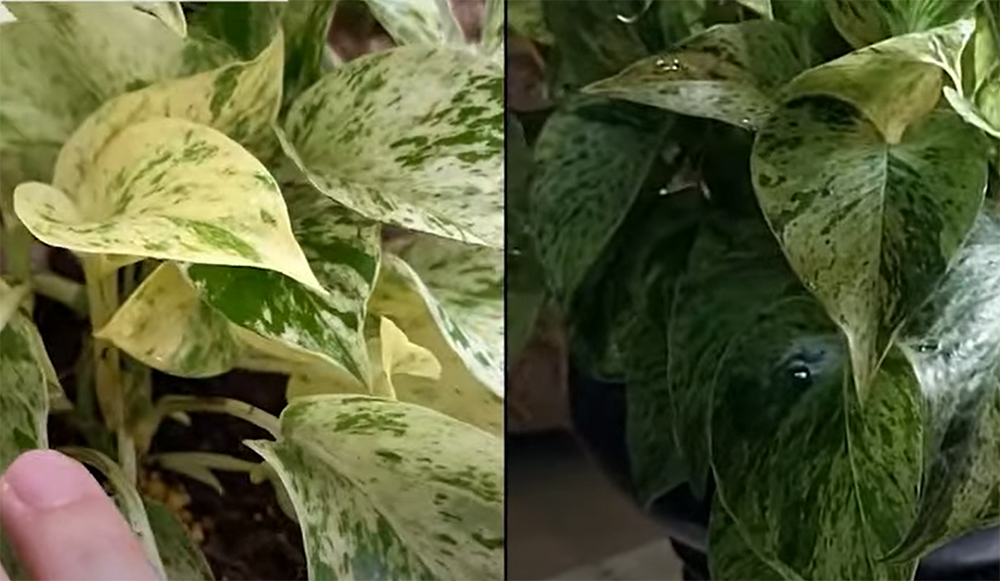
Light
The first thing to consider is the amount of light it’s getting. Light is very important because it helps the plant produce energy through photosynthesis. A lack of light will cause your plant to be leggy and stretched out.
If you live in a place with lower light levels, you can place your Marble Queen Pothos near a window that gets plenty of sunlight. Just be sure to rotate the plant every week or so to ensure that all sides are getting an equal amount of light.
If your home is like mine and lacks bright windows, don’t despair! These plants are pretty tolerant of lower light levels. Just be sure to avoid direct sunlight, which can cause the leaves to scorch. Moreover, if you’re growing your plant indoors, it’s a good idea to supplement with artificial light.
The best type of light to use is fluorescent light. You can buy a grow light or use a desk lamp with two 60-watt bulbs. Just be sure that the light is shining on the leaves of the plant for at least 14 hours a day.
If you are able to provide a sunny spot for your Marble Queen Pothos, however, they will reward you with beautiful leaves that range in color from light green to dark green with swirls of creamy white.
If you notice the leaves start to turn yellow or pale, that’s a sign it’s not getting enough light and you should move it to a brighter spot. In addition, if the leaves start to drop off, that’s another sign of too little light.
Watering
Watering is another important factor to consider when caring for your Marble Queen Pothos. Water is a necessary part of any plant’s life, but too much or too little water can be detrimental to your plant. That’s why it’s important to understand your plant’s watering needs and how to meet them.
This plant likes to be kept moist, but not soggy. Overwatering can lead to root rot, which can be fatal to your plant. To water your new plant, simply give it a good soaking once the top inch of soil has dried out.
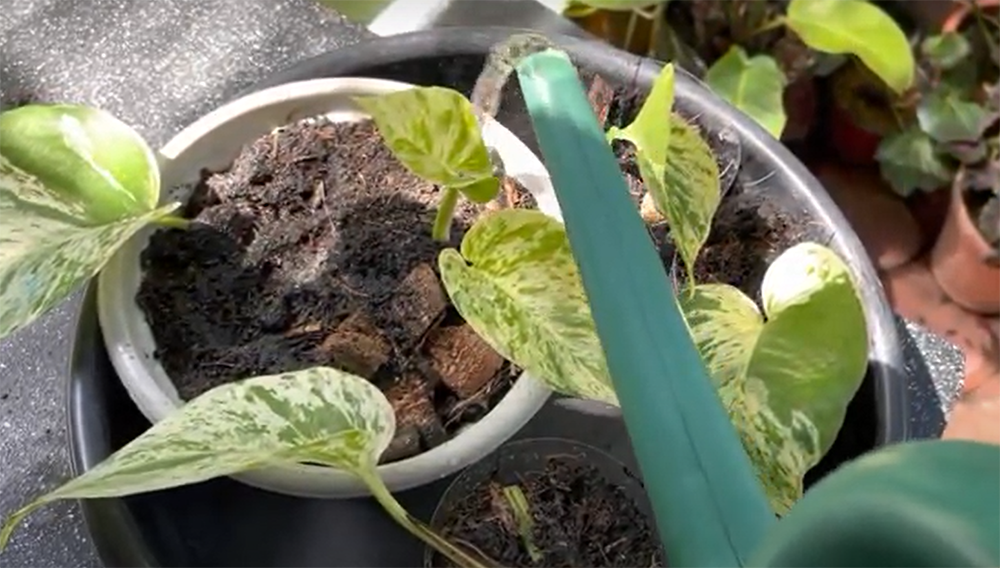
If you’re not sure if your plant needs water, check the leaves. When they start to droop, it’s a sign that your plant is thirsty.
Watering your plant from the bottom up is a good way to make sure it’s getting enough water without risking overwatering. To do this, simply place your plant in a bowl or sink of lukewarm water and let it soak for about 15 minutes.
Allow the top layer of soil to dry out in between watering. Watering once a week should be sufficient, but you may need to water more often during periods of high heat or low humidity.
During the winter months, you can reduce watering to every other week or so. Just be sure to check the soil before watering to make sure it is actually dry.
Under-watering your plant can also cause problems. If the leaves start to droop and turn yellow, it means your plant is not getting enough water. In this case, you will need to water more frequently until the leaves return to their normal color.
If you often forget to water your plants, or if you’re going on vacation, consider getting a self-watering pot. These pots have a reservoir that slowly waters the plant over a period of time, so you don’t have to worry about watering your plant while you’re away.
One more variant is a water timer. This is a small device that attaches to your watering can and regulates the amount of water it dispenses, so you don’t have to worry about over or under-watering.
Humidity
The next thing to consider for your new plant care is humidity. It should be taken into account, especially if you live in a dry climate. Many plants will benefit from being placed in a humid environment, and the Marble Queen Pothos is no exception.
Most pothos enjoys high humidity, but the Marble Queen does just fine in lower levels. However, they won’t be against humid conditions, so you’ll want to make sure the air around them is nice and moist. You can increase the humidity around your plant by misting it regularly or placing it in a humid environment.
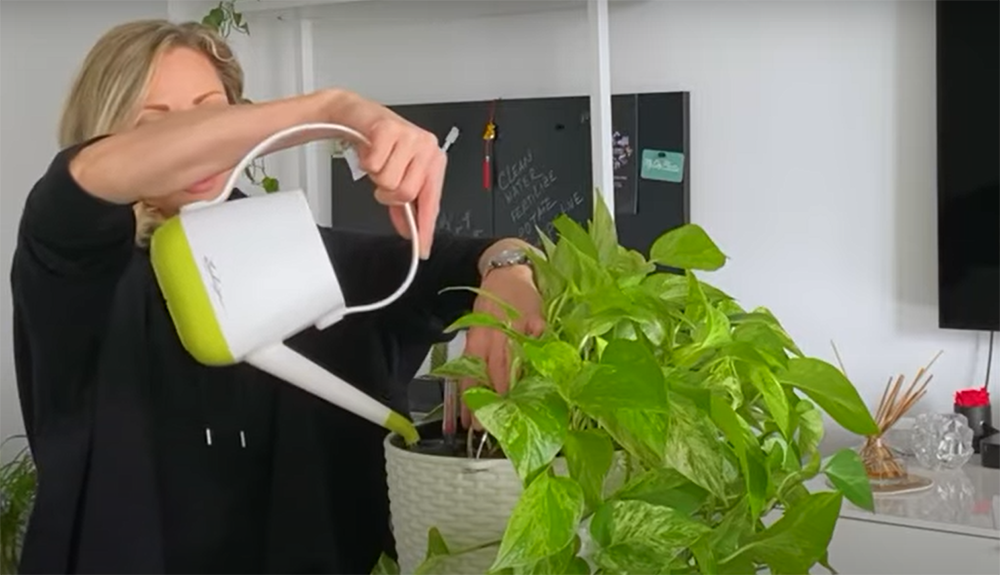
There are many ways to create humidity for your plants. Some of them are:
- The first way is to use a humidity tray. You can make your own by placing rocks or gravel in a shallow dish and adding water. Be sure the water doesn’t touch the bottom of the pot your plant is in. If it does, the pot will likely rot. You can also place the pot on a wet towel or in a saucer of water.
- The second way to increase humidity is to use a humidifier. If you have one in your home, this is a great option for keeping all of your plants happy and healthy. If you don’t have a humidifier, there are many small and portable ones on the market that are affordable and easy to use.
- The third way is to place your plant near a water source. This could be a fish tank, fountain, or even another plant that releases moisture into the air. It works best if the plant is in a pot that can easily absorb water.
- The fourth way to increase humidity is by group planting. When you have more than one pothos plant together, they will help each other out by releasing moisture into the air. This will create a microclimate where the plants can exchange moisture amongst themselves. When you do this, the evaporation from the leaves will increase the moisture in the air around them. This is a good variant if you don’t have a lot of space or if you want to keep your plants close together.
- The fifth way to increase humidity is to grow the plant in a terrarium. This is a great option for those who want to create their own little ecosystem. By growing the plant in a terrarium, you can control the environment and make sure it stays humid. This is also a great way to keep the plant out of reach of pets or children.
Terrariums are easy to make and there are many kits available that include everything you need. All you need is a container, some soil, and your plants.
If you’re having difficulty keeping the humidity high enough for your pothos, don’t worry! There are many ways to increase it and with a little effort, you can keep your plant happy and healthy.
There are at least five ways to increase the humidity for your plants, so choose the one that works best for you and your home. Be sure to experiment with different methods to find what works best for you and your home.
So, now that you know a little bit about humidity and how to increase it for your pothos, you can be sure to give them the best environment possible!
Temperature
Another thing to keep in mind with your Marble Queen Pothos is temperature. It is important because it can affect the growth rate of your plant. Moreover, too much heat can cause the leaves to scorch.

The ideal temperature for a Marble Queen Pothos is between 65-85 degrees Fahrenheit. If you live in an area with hot summers, it is best to grow your plant in partial shade. [1]
Temperatures below 65 degrees Fahrenheit can damage the leaves, so make sure to keep an eye on the thermostat if you have your plant outdoors. If the temperature gets too low, the leaves will start to turn brown and die.
Temperatures above 85 degrees Fahrenheit can also be harmful to the plant. The leaves will start to droop and turn yellow if it is exposed to too much heat. If the temperature gets too high, the leaves will start to curl and drop off.
The best way to ensure that your plant is getting the right temperature is to use a thermometer. They are easy to find at any hardware store.
Additionally, the roots of your plant are very sensitive to changes in temperature. Therefore, it is important to keep the soil temperature consistent. You can do this by using a soil thermometer. Soil thermometers are also easy to find at any hardware store.
Monitor temperature at least once a week to make sure that your plant is healthy and happy.
You can increase the temperature by using a heat mat or a grow light. You can decrease the temperature by moving your plant to a cooler location or by using a fan.
Just remember to keep an eye on the temperature, and your plant will be happy and healthy.
Soil
The next thing you need to consider when caring for your Marble Queen Pothos is the soil. There are a lot of different soil mixes you can use, so it can be confusing to know which one to choose.
A good rule of thumb is to use a mix that is well-draining and has a lot of organic matter. This will help to ensure that your plant stays healthy and doesn’t suffer from root rot.
It is important to use a potting mix that drains well. The most common type of potting mix is made up of peat moss, vermiculite, and perlite. I recommend using a mix of 50% potting soil and 50% perlite. This will help keep the plant’s roots from becoming too wet or too dry.
If you’re having trouble finding perlite, you can also substitute it with vermiculite. Just make sure that your soil mix has a good amount of organic matter.
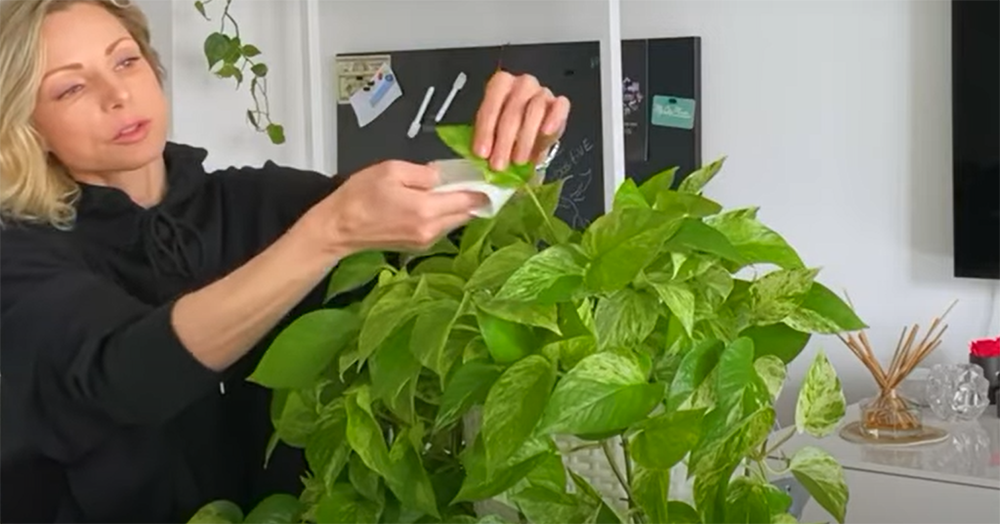
You can also make your own potting mix by mixing together equal parts of peat moss, perlite, and sand. This mix will drain well and provide the plant with the nutrients it needs to thrive.
No matter what mix you choose, make sure that it drains well and contains plenty of organic matter. This will help your Marble Queen Pothos stay healthy and happy for many years to come.
If you use the wrong type of soil mix, your plant could suffer from root rot or other problems. So make sure to choose a mix that is well-draining and has plenty of organic matter.
The wrong type of soil mix can also cause the leaves of your plant to be yellow or brown. So it’s important to choose a mix that will help keep your plant healthy.
Moreover, using the wrong soil mix can also make it difficult for your plant to absorb nutrients. This can lead to a number of problems, so it’s important to choose the right mix.
When in doubt, ask the staff at your local garden center for help. They will be able to recommend a soil mix that is suitable for your plant.
Repotting
One more task that should be completed every one to two years is repotting. Every plant needs a little extra room to grow roots and fill out its pot. Pothos are no different! You’ll know it’s time to repot your pothos when you see the plant’s roots filling up the entire pot or if the leaves start to yellow.
Repotting will help refresh the soil and get rid of any pests or diseases that may have taken hold.
Be sure to use a well-draining potting mix. Water thoroughly after repotting, and allow the soil to dry out slightly before watering again.
When you do repot, be sure to use a pot that is only one size larger than the current container. The plant’s roots will fill up the pot in no time, so you’ll want to give it plenty of room to grow.
If the pot is too large, the plant’s roots will become waterlogged and rot. If it is too small, the plant will become root-bound and stunt its growth. So make sure to find that happy medium!
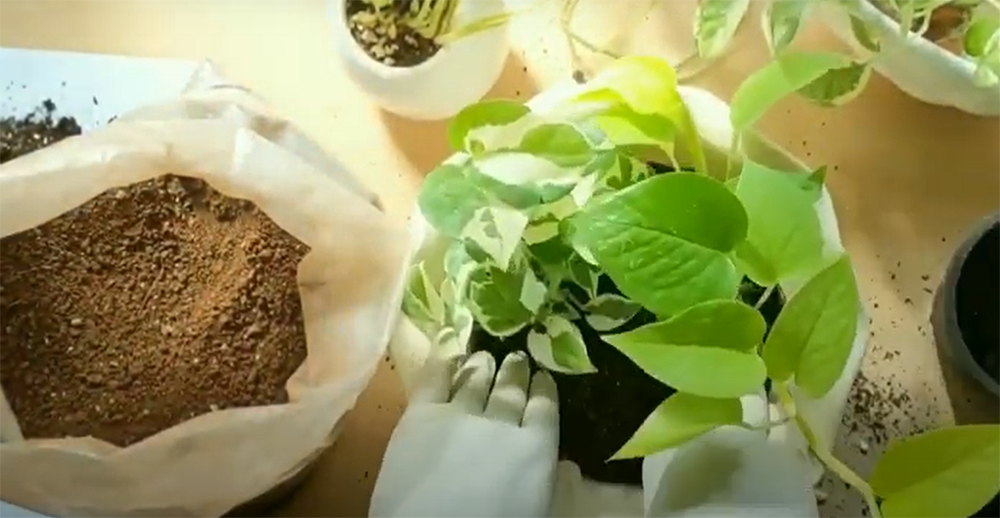
If you are not sure how to repot a plant, there are plenty of online tutorials that can help. However, be sure to research the proper way to do it for your specific type of plant.
Failure to properly repot a plant can lead to its death, so it is important that you take the time to do it correctly.
Fertilizing
Fertilizing is another aspect that should be considered. It is important because it provides the nutrients that the plant needs to grow.
The best way to fertilize is to use a water-soluble fertilizer and apply it every two weeks. During the growing season, you can increase the frequency to once a week.
Use a balanced fertilizer that is low in nitrogen. It means that the fertilizer should have an equal amount of nitrogen, phosphorus, and potassium.
An easy way to remember this is that the numbers on the fertilizer should be close to each other. For example, 20-20-20 or 15-15-15.
It is important to choose the right one because an overabundance of nitrogen can cause the leaves to turn yellow and fall off.
If you notice the leaves turning yellow, this is a sign of over-fertilization. Cut back on fertilizer or flush the soil to remove excess fertilizer.
An easy way to remember the rule of thumb is to fertilize your plant when it is actively growing. This is typical during the spring and summer months.
If you live in an area with a long growing season, then you can fertilize throughout the year. Just be mindful of the leaves and make sure they are not turning yellow.
A little goes a long way when it comes to fertilizing pothos plants. Too much fertilizer can damage or even kill the plant, so be sure to follow the instructions on the package carefully. And remember, less is more!
Propagation
Propagation is the process of creating new plants from a parent plant. There are many ways to propagate plants, but one of the most common ways to propagate pothos is by stem cuttings.
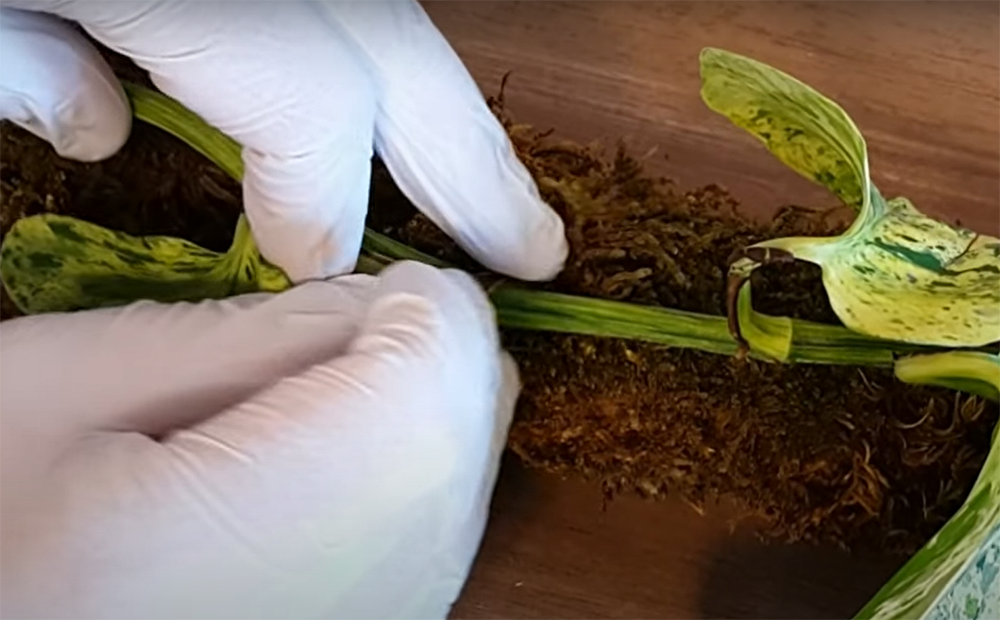
- To take a stem cutting, use a sharp knife or pair of scissors to cut a piece of stem that contains at least two leaves. Make sure to cut the stem below a node, which is the point where a leaf meets the stem. Remove any buds from the cutting, and then place them in water until you are ready to plant them.
- If you are propagating your pothos by rooting a cutting in soil, wait until the cutting has grown a few new leaves before planting it in the soil. Pothos can be propagated by root division as well, but this is not commonly done.
One more way to propagate pothos is by air layering. Air layering is a method of propagating a plant by encouraging new roots to grow from a stem while it is still attached to the parent plant.
- To air layer a pothos, start by finding a spot on the stem that has leaves and is at least six inches long. Cut two slits in the stem, each about two inches long. Make sure not to cut into the leaves. Gently push a toothpick through each slit and into the center of the stem.
- Take a piece of plastic wrap and stretch it tight over the stem. Wrap some electrical tape around the stem to hold the plastic wrap in place. Make sure the plastic wrap is airtight.
- Wait two to four weeks, and then check the progress of the rooting process. When new roots have formed, cut the stem below the newly rooted section and plant it in the soil.
You can also propagate your plant in water. This method is similar to propagating in soil, but you will need to take extra care of your plant while it is growing.
- Place the cutting in a jar or glass of water and make sure that the leaves are above the waterline. Change the water every few days to keep it fresh. After a few weeks, you should see new roots growing from the cutting. When the roots are long enough, transplant your plant into the soil. Moreover, you can add some rooting hormones to the water to speed up the process.
Pothos are very easy to propagate, so don’t be afraid to experiment with different methods. And once you have a few new plants, you can pot them up or keep them in water. Just make sure to give them bright indirect light and keep them out of drafts.
If your plant still looks good after a few years, you can propagate it to create more plants.
Marble Queen pothos is a great choice for beginners. With a little bit of patience, you can have many new plants to enjoy.
Propagating pothos is a great way to get more plants for free. And it’s a fun project to do with kids too. Just make sure to keep an eye on the cuttings and water them regularly.
FAQ
How do you make Marble Queen grow faster?
To make your Marble Queen Pothos grow faster, give it plenty of bright, indirect sunlight and keep the soil moist but not soggy. You can also fertilize monthly with a half-strength solution to encourage growth.
Does Marble Queen Pothos look like the sun?
No, Marble Queen Pothos does not look like the sun. The leaves of this plant are patterned with shades of green and white, giving it a marble-like appearance.
Is Marble Queen Pothos safe for cats?
Yes, Marble Queen Pothos is considered safe for cats if they ingest small amounts. However, it’s always best to keep any houseplant out of reach of your pets just in case.
I’ve heard that Marble Queen Pothos is poisonous. Is this true?
No, Marble Queen Pothos is not poisonous. This plant is actually considered non-toxic to both humans and animals. However, as with any houseplant, it’s always best to keep it out of reach of young children and pets just in case.
Why does my Marble Queen Pothos have brown leaves?
If your Marble Queen Pothos has developed brown leaves, it’s likely due to either overwatering or under-watering. To remedy the situation, adjust your watering habits accordingly and be sure to let the soil dry out between waterings.
Useful Video: Marble Queen Pothos Care Guide
Final Thoughts
If you’re looking for an easy-to-care-for houseplant, the Marble Queen Pothos is a great option. With just a little bit of water and some indirect sunlight, this plant can thrive in your home or office.
>Do you have a Marble Queen Pothos? Share your care tips with us in the comments below!
If you enjoyed this article, please consider sharing it with others! And be sure to check out our other articles on houseplants for more care and propagation tips. Thanks for reading!
As always, thanks for reading! If you have any questions or comments, please leave them below. And be sure to check out our other articles on houseplants for more care and propagation tips. Happy gardening!
References:
- https://anselandivy.com/blogs/plant-care/marble-queen-pothos/
- https://www.sproutsandstems.com/marble-queen-pothos/




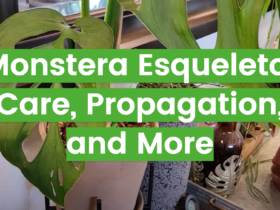
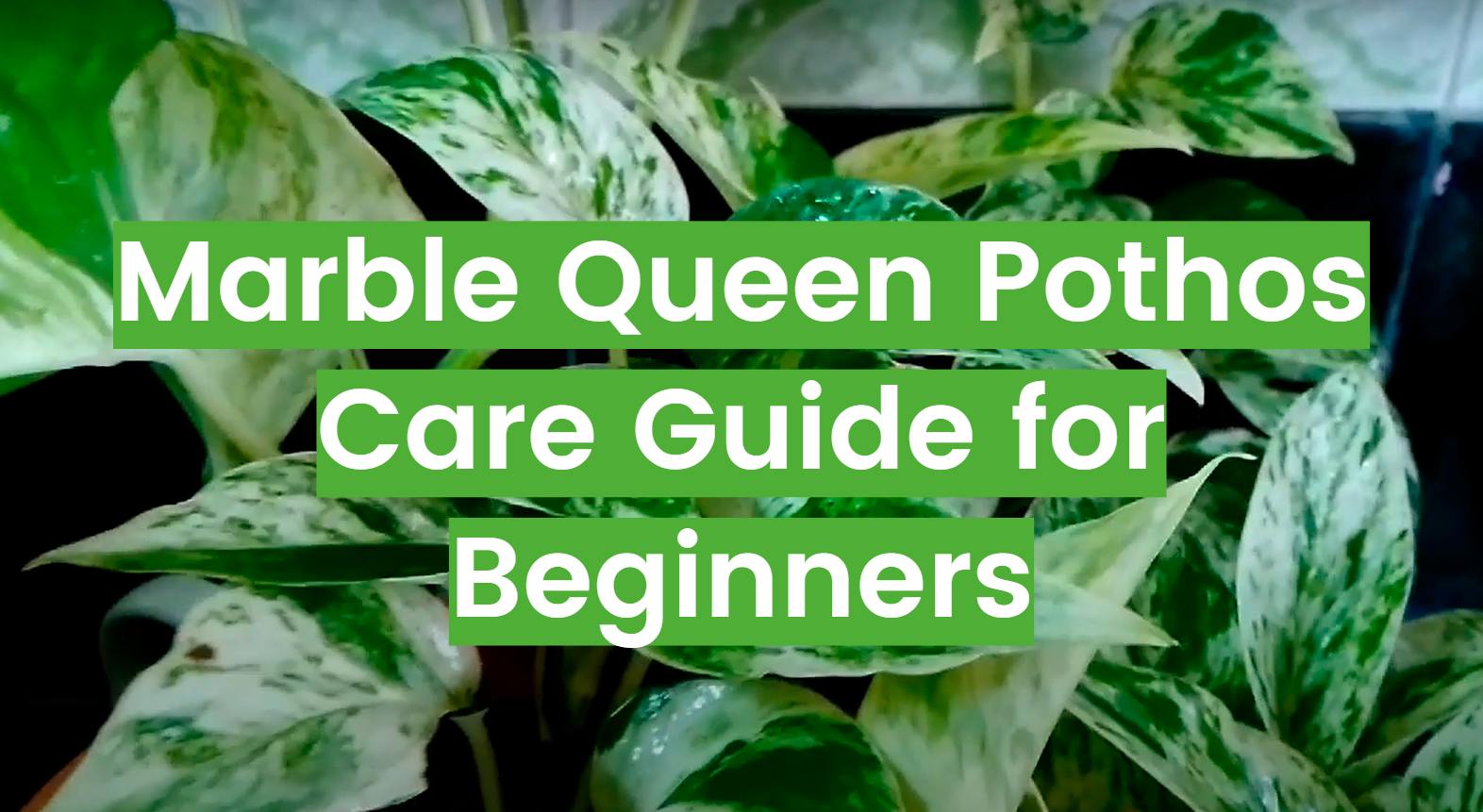



Leave a Review